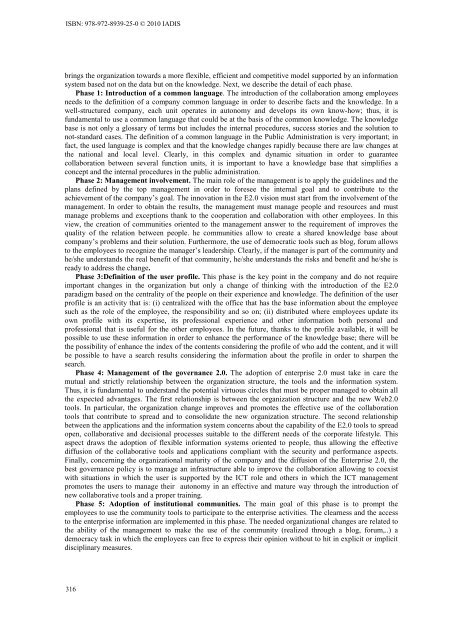WWW/Internet - Portal do Software Público Brasileiro
WWW/Internet - Portal do Software Público Brasileiro
WWW/Internet - Portal do Software Público Brasileiro
You also want an ePaper? Increase the reach of your titles
YUMPU automatically turns print PDFs into web optimized ePapers that Google loves.
ISBN: 978-972-8939-25-0 © 2010 IADISbrings the organization towards a more flexible, efficient and competitive model supported by an informationsystem based not on the data but on the knowledge. Next, we describe the detail of each phase.Phase 1: Introduction of a common language. The introduction of the collaboration among employeesneeds to the definition of a company common language in order to describe facts and the knowledge. In awell-structured company, each unit operates in autonomy and develops its own know-how; thus, it isfundamental to use a common language that could be at the basis of the common knowledge. The knowledgebase is not only a glossary of terms but includes the internal procedures, success stories and the solution tonot-standard cases. The definition of a common language in the Public Administration is very important; infact, the used language is complex and that the knowledge changes rapidly because there are law changes atthe national and local level. Clearly, in this complex and dynamic situation in order to guaranteecollaboration between several function units, it is important to have a knowledge base that simplifies aconcept and the internal procedures in the public administration.Phase 2: Management involvement. The main role of the management is to apply the guidelines and theplans defined by the top management in order to foresee the internal goal and to contribute to theachievement of the company’s goal. The innovation in the E2.0 vision must start from the involvement of themanagement. In order to obtain the results, the management must manage people and resources and mustmanage problems and exceptions thank to the cooperation and collaboration with other employees. In thisview, the creation of communities oriented to the management answer to the requirement of improves thequality of the relation between people. he communities allow to create a shared knowledge base aboutcompany’s problems and their solution. Furthermore, the use of democratic tools such as blog, forum allowsto the employees to recognize the manager’s leadership. Clearly, if the manager is part of the community andhe/she understands the real benefit of that community, he/she understands the risks and benefit and he/she isready to address the change.Phase 3:Definition of the user profile. This phase is the key point in the company and <strong>do</strong> not requireimportant changes in the organization but only a change of thinking with the introduction of the E2.0paradigm based on the centrality of the people on their experience and knowledge. The definition of the userprofile is an activity that is: (i) centralized with the office that has the base information about the employeesuch as the role of the employee, the responsibility and so on; (ii) distributed where employees update itsown profile with its expertise, its professional experience and other information both personal andprofessional that is useful for the other employees. In the future, thanks to the profile available, it will bepossible to use these information in order to enhance the performance of the knowledge base; there will bethe possibility of enhance the index of the contents considering the profile of who add the content, and it willbe possible to have a search results considering the information about the profile in order to sharpen thesearch.Phase 4: Management of the governance 2.0. The a<strong>do</strong>ption of enterprise 2.0 must take in care themutual and strictly relationship between the organization structure, the tools and the information system.Thus, it is fundamental to understand the potential virtuous circles that must be proper managed to obtain allthe expected advantages. The first relationship is between the organization structure and the new Web2.0tools. In particular, the organization change improves and promotes the effective use of the collaborationtools that contribute to spread and to consolidate the new organization structure. The second relationshipbetween the applications and the information system concerns about the capability of the E2.0 tools to sprea<strong>do</strong>pen, collaborative and decisional processes suitable to the different needs of the corporate lifestyle. Thisaspect draws the a<strong>do</strong>ption of flexible information systems oriented to people, thus allowing the effectivediffusion of the collaborative tools and applications compliant with the security and performance aspects.Finally, concerning the organizational maturity of the company and the diffusion of the Enterprise 2.0, thebest governance policy is to manage an infrastructure able to improve the collaboration allowing to coexistwith situations in which the user is supported by the ICT role and others in which the ICT managementpromotes the users to manage their autonomy in an effective and mature way through the introduction ofnew collaborative tools and a proper training.Phase 5: A<strong>do</strong>ption of institutional communities. The main goal of this phase is to prompt theemployees to use the community tools to participate to the enterprise activities. The clearness and the accessto the enterprise information are implemented in this phase. The needed organizational changes are related tothe ability of the management to make the use of the community (realized through a blog, forum,..) ademocracy task in which the employees can free to express their opinion without to hit in explicit or implicitdisciplinary measures.316




